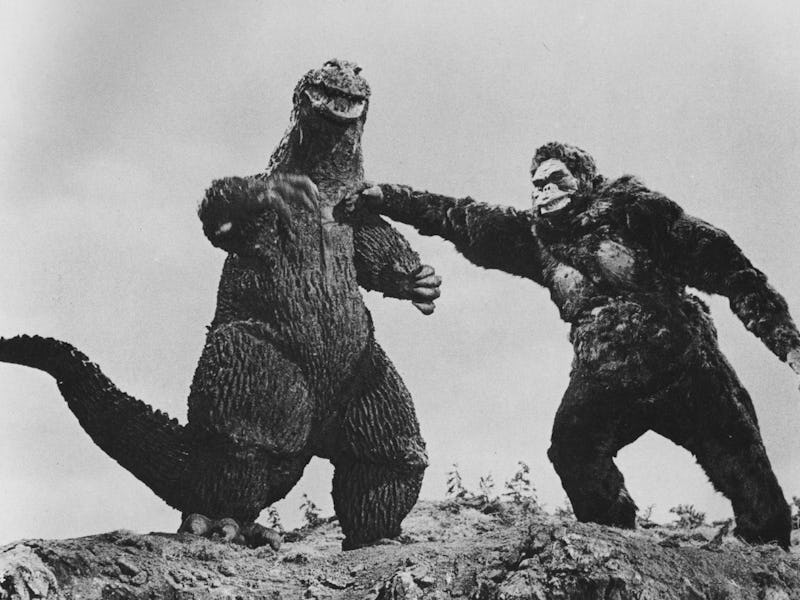A Brief History of Godzilla's Blood Feud with King Kong
And how Frankenstein's Monster was almost involved.

In the age of the ever-expanding franchise, Kong: Skull Island enters the fray with the beast of colonialism, King Kong, to usher in a new era of creature features. The new film from Jordan Vogt-Roberts is the next chapter of a new universe of giant monsters, with the main event being Kong vs. Godzilla in 2020. But the rivalry between King Kong and Japan’s personification of nuclear devastation, Godzilla, goes back much further.
Before 1962, Godzilla and King Kong were has-beens on a collision course. King Kong, who debuted in the 1933 extravaganza King Kong from Merian C. Cooper and Ernest B. Schoedsack, hadn’t had a movie since Son of Kong, a slapdash sequel released mere months after the original. Likewise, Godzilla, born from SFX innovators Ishirō Honda and Eiji Tsuburaya at Toho, had been absent for six years following 1956’s Godzilla Raids Again, a sequel to a movie that Japanese critics pretty much hated until years later. Their respective studios saw their resurrection in each other’s mutually assured monster-fueled destruction.
The making of King Kong vs. Godzilla is worthy of its own book, a tale of stolen ideas and legal loopholes exploited by powerful studios. But in short, King Kong animator Willis O’Brien came up with the idea of Kong fighting Frankenstein’s Monster, who would grow to equal size in the film. O’Brien worked with a producer, John Beck, to bring it to studios. But Beck took the idea for his own. Still, Frankenstein was nixed when Universal Studios’ ownership of the character — Mary Shelley’s monster is in the public domain, but the iconic version is Universal property — prevented this from happening. A substitute for Frankenstein was considered, but stop-motion animation was just too expensive. Beck then met with Toho, who not only wanted to make a King Kong film but also bring Godzilla back after his six-year absence.
William O'Brien's original concept art for 'King Kong vs. Frankenstein,' which later became 'King Kong vs. Prometheus.'
No one was more excited than Tsuburaya, who was inspired to work in cinema because of King Kong and put his own project Kaguyahime, a fantasy movie based on a 10th-century fairy tale, to the side. Tsuburaya got to work with his team creating new suits from scratch: The new Godzilla suit would define the icon for decades, but King Kong buffs aren’t fond of their hero in King Kong vs. Godzilla. As Super Mega Monkey wrote in a retrospective review: “Toho’s Kong is like a gorilla suit designed by a guy whose only knowledge of primates is pictures of orangutans. Bad. So bad.”
Eiji Tsuburaya, on the set of 'King Kong vs. Godzilla.'
Though the suits were a mixed bag, the two lead costume actors, Shoichi Hirose (King Kong) and Haruo Nakajima (Godzilla), were given creative freedom to act as they wished. They trained for hours studying the matches of the beefy Toyonobori, a rising star in Japanese pro wrestling which was fast becoming a crazy popular attraction.
The work paid off: King Kong vs. Godzilla crushed the Japanese box office in 1962 like how King Kong canonically crushed Godzilla, being declared the winner despite a seemingly ambiguous ending. The film has now become a can’t miss classic of the genre, with its kitschy, low-grade effects part of its appeal.
A short year later, a separate “American” version of the film was released in the states. Made in similar fashion to Gojira becoming Godzilla: King of the Monsters with Raymond Burr, the film was rewritten to feature American characters witnessing the brawl. Shot in three days by director Thomas Montgomery, TV actor Michael Keith played a United Nations reporter doing commentary on the action from UN Headquarters while Arnold Johnson played a New York museum director to dump exposition on Godzilla and King Kong biology. It performed modestly well, with a reported profit of $1.25 million in theatrical rentals.
King Kong and Godzilla haven’t seen each other again in more than 50 years. Toho followed the success of King Kong vs. Godzilla with the standalone King Kong Escapes, directed by Honda, in which the gorilla fights his robot double Mechani-Kong created by the evil Dr. Who (not the British one). A subsequent legal battle over ownership of Kong made it prohibitive for Toho to include Kong in future Godzilla movies.
Left: Japanese poster for 'King Kong vs. Godzilla.' Right: The American poster.
While King Kong has come back in one way or another in the decades since, Godzilla has battled a slew of beasts like Rodan, King Ghidora, Destroyah, and Gigan. In Japan, he’s been reborn in last year’s Shin Godzilla, and in America in Gareth Edwards’ monstrously modern Godzilla. It’s the latter that set up the new monster universe that paved the way for Kong: Skull Island, and consequently the next battle where destruction is inevitable.
Kong: Skull Island is out now in theaters.